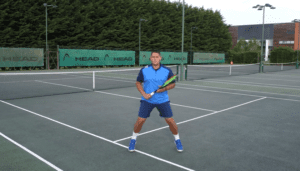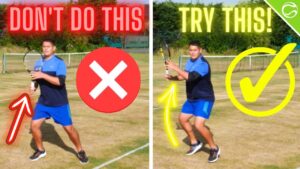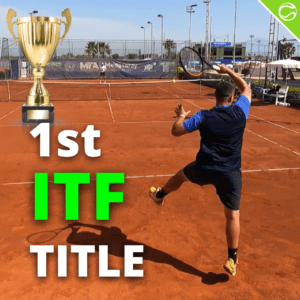
Doping In Tennis
However we do know that certain Pros have been caught using banned substances. So there is definitely a certain amount of doping going on in tennis, how much and how deep it goes is anyone’s guess. Only the Pros and the people around them know whether or not they are “clean”.
In this article I want to discuss the advantages a tennis Pro would have from taking certain banned substances and how it might benefit their tennis.
EPO has really been brought to attention via cycling and Lance Armstrong.
Erythropoietin is an essential hormone for red cell production. Without it, definitive erythropoiesis, the process of red cell production, does not take place.
Erythropoiesis-stimulating agents (ESAs) have a history of use as blood doping agents in endurance sports such as boxing, cycling, rowing, distance running, cross country skiing, biathlons and triathlons. The overall oxygen delivery system (blood oxygen levels, as well as heart stroke volume, vascularization, and lung function) is one of the major limiting factors to muscles’ ability to perform endurance exercise. Therefore, the primary reason athletes may use ESAs is to improve oxygen delivery to muscles, which directly improves their endurance capacity. With the advent of recombinant erythropoietin in the 1990s, the practice of autologous and homologous blood transfusion has been partially replaced by injecting erythropoietin such that the body naturally produces its own red cells. ESAs increase hematocrit (% of blood volume that is red cell mass) and total red cell mass in the body, providing a good advantage in sports where such practice is banned.
In theory, EPO use can increase VO2 Max by a significant amount (VO2 Max is the maximum capacity of an individual’s body to transport and use oxygen during incremental exercise, which reflects the physical fitness of the individual.
EPO is also involved in the wound healing process.
For a tennis player EPO could have significant rewards. They would be able to train harder and for longer periods of time and they would recover from training sessions and matches faster and even recover faster from injury. Imagine two tennis players, both work just as hard as the other and they are the same level. One player decides to stay clean and will do all his improvements through hard work the natural way. The other decides to start using EPO. After a few months the player who is doping will be able to train with more intensity and for a longer period of time than the clean player. Who will have improved more in the 5 years time?
Though EPO was believed to be widely used in the 1990s in certain sports, there was no way at the time to directly test for it, until in 2000, when a test developed by scientists at the French national anti-doping laboratory (LNDD) and endorsed by the World Anti-Doping Agency (WADA) was introduced to detect pharmaceutical EPO by distinguishing it from the nearly identical natural hormone normally present in an athlete’s urine.
So it is very possibly that some tennis pros were using EPO all the way through the 1990s without fear of even being tested for it.
Anabolic steroids are drugs that have similar effects to testosterone in the body. They increase protein within cells, especially in muscles. Testosterone-Anabolic effects include growth of muscle mass and strength, increased bone density and strength, and stimulation of linear growth and bone maturation.
Another less talked about gain from using steroids is the person produces more red blood cells. Very similar to using EPO.
A tennis player might benefit from steroids with increased muscle mass, which with the right explosive training could give them more powerful and heavier shots and more explosive speed in general. Another benefit might be more body weight on strokes including the serve.
Amphetamines, sometimes called “speed” or “uppers,” are central nervous system stimulant drugs that increase alertness, self-confidence and concentration, and decrease appetite while creating a feeling of increased energy. The chemical structure is similar to the naturally occurring adrenaline and noradrenaline that is produced by the body. The effects of amphetamines are similar to cocaine, but last longer. Amphetamines may provide some minor, short-term benefits. Current research shows that 10-30 mg methamphetamine may improve reaction time, and cognitive function, increase the feelings of alertness, decrease a sense of fatigue and increase euphoria.
Amphetamine has been, and is still, used by militaries around the world.
So would a tennis player gain an edge by using stimulants? 100%.
Increased alertness, concentration, energy and confidence would help most players to train harder and focus more on the task and they would gain a massive edge in competition if using stimulants.
Victor Conte is president of BALCO, a sports nutrition center in California. He served time in prison in 2005 after pleading guilty to conspiracy to distribute steroids and money laundering. later founded the Bay Area Laboratory Co-operative or BALCO, a sports nutrition center in California, which the USADA says developed the banned steroid tetrahydrogestrinone (THG) with the help of bodybuilding chemist Patrick Arnold. Pursuant to a plea bargain struck with prosecutors, he entered guilty pleas in July 2005 to one count of conspiracy to distribute steroids and a second count of laundering a portion of a check, he was sentenced in October to spend four months in prison and another four on house arrest.
In December 2004, he participated in an interview with Martin Bashir on ABC’s 20/20 program, where he admitted to running doping programs, which have broken Olympic records, as well as revealing that: “The whole history of the games is just full of corruption, cover-up, performance-enhancing drug use.”
In the below interview Victor talks in great detail about PEDs in sport and really breaks down how deep it goes
Doctor Eufemiano Fuentes is a Spanish sports doctor best known for being implicated in the Operación Puerto doping case. Fuentes was once an athlete. Fuentes was arrested by the Guardia Civil on May 22, 2006, In Fuentes’ clinic in Madrid, 186 blood bags were found belonging to professional athletes and marked with coded names, besides EPO, steroids, and growth hormone. Fuentes continually denied having performed illegal operations and also said that he did not work exclusively with cyclists but had other athletes as clients such as footballers, track and field athletes and tennis players. However in December 2010, he is quoted saying: “If I would talk, the Spanish football team would be stripped of the 2010 World Cup” In a further doping scandal, in 2010, Fuentes was arrested by Spanish police as part of Operación Galgo (Operation Greyhound). In a series of simultaneous raids across five provinces on 9 December, Spanish police seized a large quantity of anabolic steroids, hormones and EPO, as well as laboratory equipment for blood transfusions. In January 2013, the Operacion Puerto trial went underway, and Fuentes offered to reveal the names of all the athletes he helped doping. The judge, Julia Santamaria, told him that he was not under obligations to name any other athletes others than the cyclists implicated. Fuentes stated that he supplied athletes in other sports with drugs and said: “I could identify all the samples [of blood]. If you give me a list I could tell you who corresponds to each code on the [blood] packs.” Spain lacking anti-doping laws, Fuentes was charged with “endangering public health”. His main defense consisted in saying that the blood transfusions were conducted safely and were healthy for the athletes. Dr. Fuentes wife, Cristina Perez, herself a former Olympian gave more interesting claims-
The wife of the doctor at the centre of the ‘Operation Puerto’ doping affair said she could bring down Spanish sport if she revealed all to which she was privy. In an interview with La Provincia newspaper, the wife of Dr Eufemiano Fuentes, Cristina Perez, a European 400m bronze medallist in 1987, said: “I know what happened at the Barcelona Olympics in 1992.” Perez said “many Olympic medals” were won by Spain thanks to her husband. Spain won a record 13 gold medals at the Barcelona Games. “It’s a Pandora’s Box and if opened one day, it could bring down sport,” Perez said. “But out of respect for my companions, to the people who sacrificed so much, I’m keeping mum although I could speak out and ruin all those caught up in this little world.” Fuentes is reported to have been the mastermind of a vast blood doping network, which was dubbed ‘Operation Puerto’ in May 2006 following a police raid on his Madrid laboratory which uncovered doping products and blood bags.
While names of around 200 ‘clients’ from the world of sport were reportedly found, only a few have been sanctioned. Perez, 43, herself suspected of doping at the Seoul Olympics in 1988, defended her husband, saying he had been a victim of a campaign by the Spanish government. “To call a doctor dedicated to sports science who has killed no one a criminal mastermind seems shameful to me.”I do not in any way condone the use of or encourage anyone to use these banned Performance Enhancing Drugs.
No one really knows the long term health effects of any of these drugs on the body. This article is simply showing you that there are massive gains to be made by cheating and tennis is a massive business that makes a massive amount of money every year and for some Pros who are struggling to get by on the Challenger or Futures circuit you can see why they might take a shortcut to try and reach success. It would be naive of anyone to think that professional tennis is completely clean when there is so much money to be made from doing well. And if you know the next guy is cheating and you want to be the best then you might feel that using PEDs is the only way to make it a level playing field.
Guy Forget: “I don’t feel our sport is clean. I am sure now as we speak there are some guys that are cheating. You cannot say tennis is not touched by this poisonous thing.”
Mike Bryan: “You get blood tested at the slams, usually after you lose, but I’ve never been blood tested out of competition.”
Todd Martin: “There are people out there who don’t have the ethics that are necessary for there to be a level playing field, and as long as there are, we’re going to have those who are trying to get a leg up.”
Jim Courier: “Let’s face it, if you’re 100 in the world and you think that something illegal will get you to 10 in the world, that’s a tremendous difference in the quality of the rest of your life from a financial standpoint.”
Nick Bolletieri: “If I said tennis is totally clean, I would be kidding myself [..] I would say there are certainly some short cuts being taken. Not that many, but it would be crazy to think differently.”
James Blake: “In tennis, I think, I’m sure there are guys who are doing it, getting away with it and getting ahead of the testers.”
John McEnroe: “You can tell when someone has been on steroids… A guy bulks up, has a new body and never gets tired…You see these guys or girls who come onto the tour talking about their new training programs and their diets where they eat this or that new thing…but they’ll never tell you about the drugs they took.”
Jim Courier: “I’m much more inclined to have a concern for something that we cannot test for under the current system of testing, which is blood doping…”
Mardy Fish: “This is my 11th year. I’ve seen a few guys come and go who have cheated…”
Daniel Nestor: “We suspect that there’s always stuff going on. I mean, we watch some of these matches, the guys play five hours and come back the next day and do it again.”
Mahesh Bhupathi: “The tennis players themselves have brought it (anti-doping rules) upon themselves. A lot of players have been cheating.”
Jim Courier: “EPO is the problem, I have pretty strong suspicions that guys are using it on the tour. I see guys who are out there week in and week out without taking rests. EPO can help you when it’s the fifth set and you’ve been playing for four-and-a-half hours.”
Christophe Rochus: “There’s a lot of cheating. Simply, people don’t like to talk about it…I simply would like to stop the pretending. This hypocrisy is exasperating.”
Fabrice Santoro: “I can’t believe there is a real will to fight against doping…I don’t know whether the testing is done to catch the guys or just for show. Sometimes, I ask myself the question, when I see what goes on.”
Nicolas Escudé: “They tell me there are files that can’t be opened. What can they be, if not files on doping? If these files exploded, tennis would be in bad shape for six months. But it would be a bad thing for a good cause.”
Andrew Ilie: “The problem is so bad that you might as well just let them use it and when players see people dying on court and exploding, then it’s going to change their minds.”
Nathalie Tauziat: “I won’t name individuals, but it’s clear that doping exists in tennis and needs to be stopped…I have no hard evidence, but all I will say is that you don’t have to have a degree in medicine to see that some of the players have transformed themselves almost overnight…”



